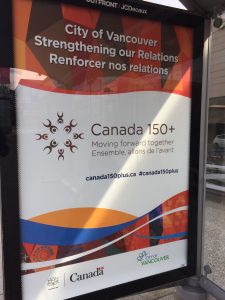Erasure of Coloniality

I noticed this advertisement as I got off the bus earlier this week. As Canada approaches its 150th anniversary of confederation, we are bound to see more nationalistic symbols everywhere as we go about our day to day lives. This particular ad is somehow related to indigenous folks and their place in the Canada 150 celebrations, specifically indigenous folks in the Greater Vancouver Area. However, it took some inferences to arrive at this fact as it is not quite clear what the ad’s point is, other than that it is about our confederation. Aboriginality is never clearly identified in the ad, but the phrase “reinforcing our relations” and the Aboriginal art work motif that decorated the text leads one to the conclusions that it has to do with Aboriginal Canadians and their place in the history of Canada. I chose this particular piece to analyze because of the striking similarities I noticed between it and the girls’ education paraphernalia that Katie MacDonald analyzes in her piece. This bus stop ad ties together the local politics of the city (Vancouver) with the national/global politics of colonialism.
The first thing that I noticed was the way that it hails the local Vancouverite with its message much in the same way that Western organizations to support girl’s educations hail the Westerners that are targeted in their campaigns (MacDonald, 2015:1). The ad assumes a oneness of all and states that we are, “Moving forward together” in this 150th year since confederation. Still following from MacDonald’s ideas, I would argue that this “hailing” centres the concept of futurity for indigenous folks in Canada. Similar to the way Plan Canada and The United Nations Girls Education Initiative perseverate on “the possibility of future suffering” in their construction of the girl’s image and take away from the concept of the “immediate suffering”, the ad only focuses on the future (MacDonald, 2015:2). This erasure is easily furthered by MacDonald’s idea about ads and their potent “neoliberal, apolitical” modes of operation, which are “reliant on ideas of modernity” (MacDonald, 2015:6).
What is missing, aside from the Aboriginal art flanking the Canada 150+ symbol, is any other mention of indigeneity. The advertisement is bolstered at the top and bottom by symbols of State and municipal power. The locality of indigenous peoples in Vancouver is effectively diminished by these shows of colonial, national power. The celebration of Canada in this way, as a global, nation state is continued through this bus stop ad in the same way it is through other iterations: TV snippets, magazine ads, numismatically etc. The lurking reality of the fact that “Canada” as we now know it had a history prior to 150 years ago is easily displaced by the ad. Cleanly translated into English and French – our colonial languages – we do not see any trace of the indigenous languages of the Musqueam or Coast Salish peoples that used to be spoken in so-called Vancouver. As a global city, this is the kind of image that is being projected toward those that witness he ad, and those that are hailed by it. Individuals encountering the ad with a less critical lens may only see it as a billboard for Canada’s liberalized, “multicultural” values.
In sum, this ad really stuck out for me because of the colonial politics of erasure that it embodies. In thinking about the way that MacDonald articulates narratives of “the girl” in her work, we are able to see the same kind of modernist, political rhetoric in this confederation ad. Further, the ad contributes to the slew of nationalistic media that is circulating at the moment. This kind of media further constructs the image of Canada, both globally and locally, as a benevolent, multicultural nation state with little mention of its dark colonial past.
Works Cited
Macdonald, K. (2015). Calls for educating girls in the Third World: futurity, girls and the ‘Third World Woman’. Gender, Place and Culture, 23(1), 1-17. doi:10.1080/0966369x.2014.9.